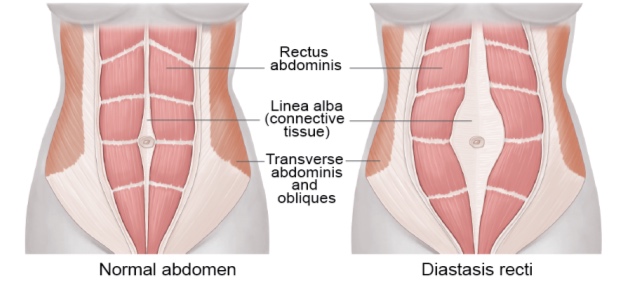Diastasis Recti: The Mommy Tummy
Up to 70% of postnatal women struggle with what is called diastasis recti, better known as abdominal separation or the “mommy tummy". Diastasis recti is a separation of the rectus abdominis (the six pack muscles) in the midline of the stomach of 2 or more finger width spaces. Abdominal separation during pregnancy is normal, but it’s only when the separation does not close up naturally within 6 weeks postpartum, that it becomes problematic. Diastasis Recti can lead to a weak core, back pain and a stubborn postpartum belly. The belly often appears as a coning or bread loaf shape along the midline of the belly, or the stomach still looks rounded as if pregnant. Many women suffering from diastasis recti report feeling like they “lost” their core strength and are no longer able to do abdominal exercises such as sit-ups and planks.
Although for many women their abdominal separation may close naturally after pregnancy, they are still experiencing the symptoms of diastasis recti. The reason for this is often that the depth, as opposed to the width of the separation(often times both) is where the problem lies. The connective tissue(linea alba) in between the rectus abdominis should be firm and tight when pressing on it, but in many postnatal women this tissue is soft and jelly-like. Soft connective tissue is a sign of a weak core that needs rehabilitation and strengthening.
Diastasis recti is just as likely to occur in two polar opposite cases:
Unfit women with large over-stretched bellies who have no core awareness or core activation.
Fit women with tiny bellies who walk around drawing their stomach in. In this case we are dealing with hyper core awareness and over-activation of the core.
Unfortunately many postnatal women make matters worse by trying to correct their diastasis recti by doing sit-ups. When putting additional pressure on the rectus abdominis you are only making the condition worse.
But there is hope! Core Restore Fitness will teach clients how to rehabilitate the inner unit of the core, which includes the diaphragm (primary breathing muscle), transverse abdominis (deep core muscles) and the pelvic floor muscles. Reconnecting and strengthening these muscles after birth is of the utmost importance, and it’s the surest way to rebuild a strong core.
At Core Restore Fitness we want to help our clients become functional and strong women who stay injury and pain free for life. A side effect of this might be that you also feel good, maintain a healthy weight, have more energy and are more content about life. Let’s get to work!

